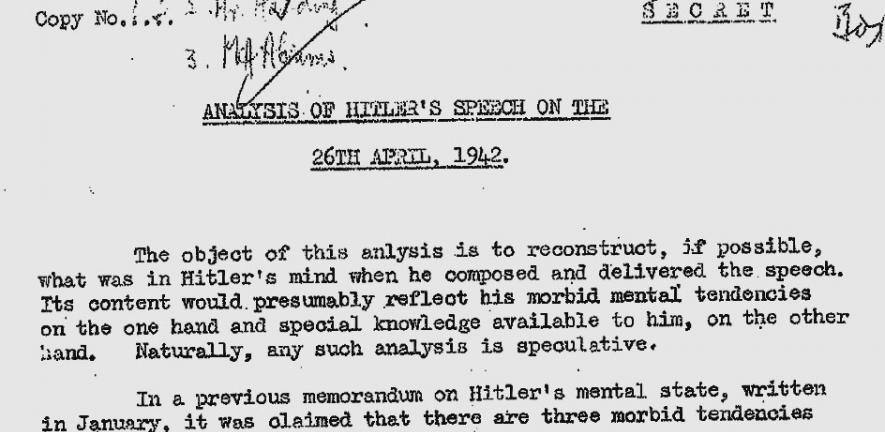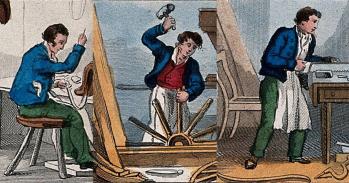
A secret report, previously unknown to historians, shows how British Intelligence was tracking Hitler’s growing preoccupation with “the enemy within” on the eve of the Final Solution.
A secret report, previously unknown to historians, shows how British Intelligence was tracking Hitler’s growing preoccupation with “the enemy within” on the eve of the Final Solution.
British Intelligence sensed this happening. Faced with external failure, the Nazi leader was focusing on a perceived ‘enemy within’ instead – namely the Jews.
Scott Anthony
A secret analysis of Adolf Hitler’s mental state which was drawn up by British Intelligence in April 1942 has been uncovered by a researcher, having apparently lain unread since the war.
The document was found among a collection of papers belonging to the family of Mark Abrams, a social scientist who worked with the BBC’s Overseas Propaganda Analysis Unit and the Psychological Warfare Branch, during World War II. Written just as the war was starting to turn against Hitler, it shows that British analysts had noticed signs of developing paranoia in his speechmaking and – chillingly – a growing preoccupation with what he called “the Jewish poison”.
The paper came to light after Dr Scott Anthony, who is working on the history of public relations at the University of Cambridge, began tracking down Abrams’ peers and relatives. Abrams, who died in 1994, was a pioneer of market research and opinion polling. He was the man responsible for the ABC1 classification system, famously predicted the rise of the teenager in 1959 and was a key figure in Harold Wilson’s modernisation of the Labour Party.
Marked “Secret”, the analysis was commissioned by Abrams at a time when his analytical talents were needed for the war effort. The document itself was written by J. T. MacCurdy, a Cambridge academic working alongside him. Anthony has spoken to experts on both Nazi Germany and the history of psychology, but nobody appears to have known about this report until now.
“At the time that it was written, the tide was starting to turn against Germany,” Anthony said. “In response Hitler began to turn his attentions to the German home front.”
“This document shows that British Intelligence sensed this happening. MacCurdy recognised that, faced with external failure, the Nazi leader was focusing on a perceived ‘enemy within’ instead – namely the Jews. Given that we now know that the Final Solution was commencing, this makes for poignant reading.”
Overseas Propaganda Analysis began in 1939 and was later linked to the Psychological Warfare Division. Each week, its staff produced an analysis of all overseas broadcasts in Germany and occupied Europe.
Abrams, already a world-renowned expert in the analysis of public opinion, believed that transcripts of the broadcasts could be close-read for propaganda and intelligence purposes. In an interview with his grandson, recorded in the 1980s and also included in the materials Anthony has helped the university acquire, he explained that doing so could reveal “latent content” – hidden, and almost subconscious insights into the enemy’s state of mind. By 1942, this highly successful technique was feeding directly into the work of Allied counter-propagandists.
This analysis was one such exercise, covering a radio speech Hitler had given on April 26, 1942. According to its opening lines, the aim was “to reconstruct, if possible, what was in Hitler’s mind when he composed and delivered the speech. Its content would presumably reflect his morbid mental tendencies on the one hand and special knowledge available to him on the other.”
MacCurdy refers to an earlier report in which he had spotted three such “morbid tendencies”, classifying these as “Shamanism”, “Epilepsy” and “Paranoia”. The first, a term of MacCurdy seems to have borrowed from anthropology, referred to Hitler’s hysteria and compulsion to feed off the energy of Nuremberg Rally-style audiences. By now it was in decline, and his report refers to the “dull flatness of the delivery”.
The other two tendencies were, however, developing. “Epilepsy” referred to Hitler’s cold and ruthless streak, but also a tendency to lose heart when his ambitions failed. MacCurdy thought the outcome of Operation Barbarossa, which had stalled the previous winter, had exposed this fatalism, and he wrote that Hitler’s speech betrayed “a man who is seriously contemplating the possibility of utter defeat.”
Most alarming, however, was Hitler’s growing paranoia. By this, MacCurdy meant the Nazi leader’s “Messiah complex”, in which he believed he was leading a chosen people on a crusade against an Evil incarnate in the Jews. He felt that this was starting to become a dominant tendency in Hitler’s mind. The paper notes an extension of the “Jew phobia” and says that Hitler now saw them not just as a threat to Germany, but as a “universal diabolical agency”.
The timing of such an analysis could not have been more prescient. Weeks before the speech, senior Nazis had set plans in motion for the Final Solution – an intensification of the mass extermination of Jews.
Neither MacCurdy nor Abrams could have known the appalling repercussions Hitler’s mental state was to have, but they clearly saw it in development. “Hitler is caught up in a web of religious delusions,” MacCurdy concluded. “The Jews are the incarnation of Evil, while he is the incarnation of the Spirit of Good. He is a god by whose sacrifice victory over Evil may be achieved. He does not say this in so many words, but such a system of ideas would rationalise what he does say that is otherwise obscure."
An archive of documents about Abrams’ life and work is held by the Churchill Archives, University of Cambridge. Mark Abrams’ family are adding the original copy of the psychoanalysis to this collection, which means that it will be available to researchers for the first time. Anthony has speculated that Abrams, who was of Jewish parentage, might have held on to his copy because of his background.
Anthony’s research will attempt to unravel the contribution Abrams made to the construction of social knowledge. “The story of his life and work reveals something of the changing ways in which public opinion has been weighed and measured, about the methods by which British democracy has tried to aggregate and respond to the demands of the electorate and by doing so has shaped some of the demands they were attempting to reflect,” he said. “This wartime work was obviously for a very specific purpose, but the growth of advertising agencies and market research after the war meant that many of the lessons learnt in the war would be applied, and built on, in the post-war period.”
This work is licensed under a Creative Commons Licence. If you use this content on your site please link back to this page.





